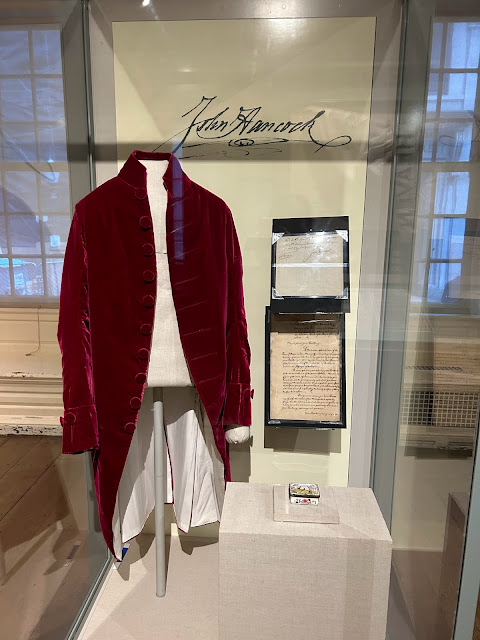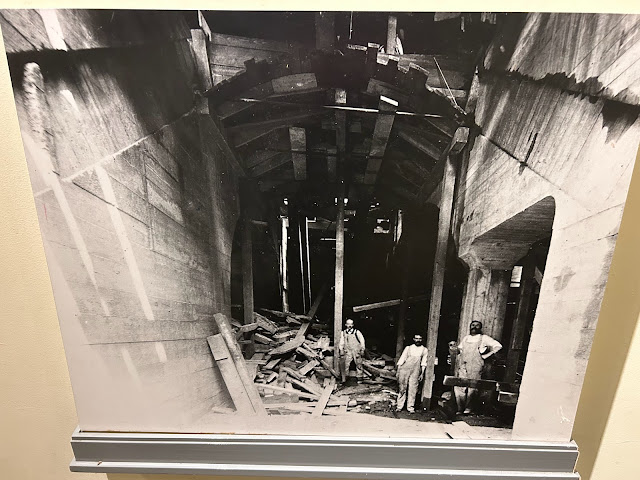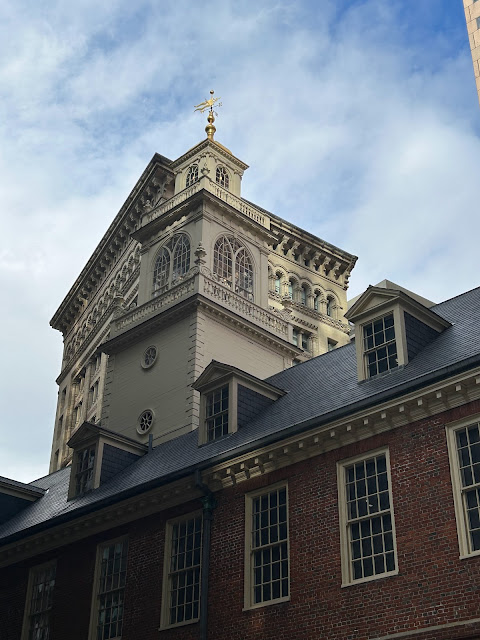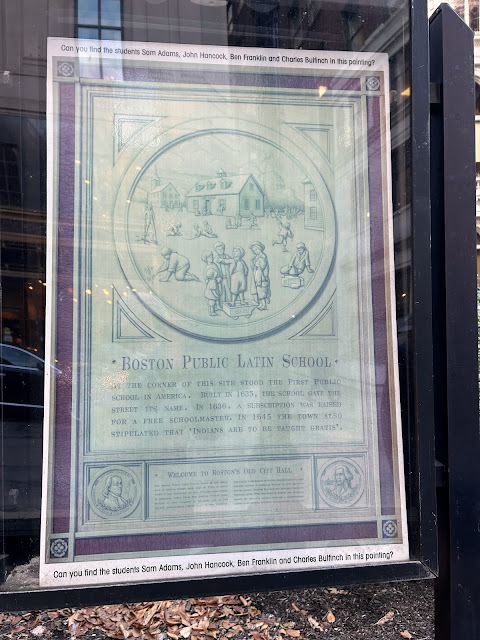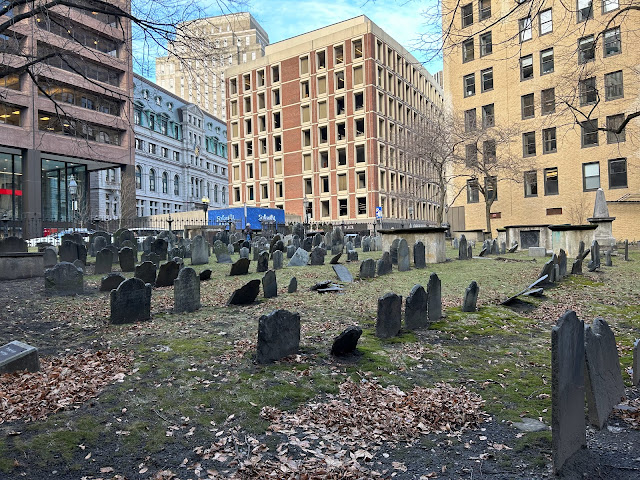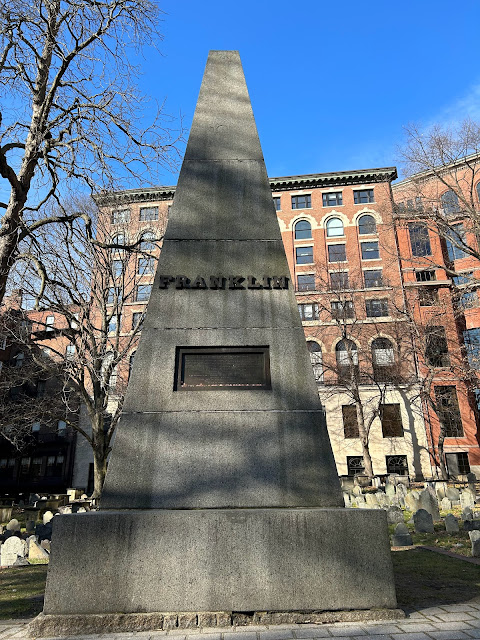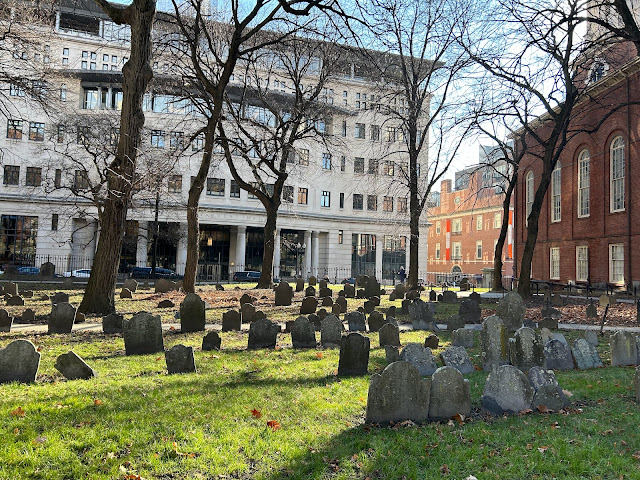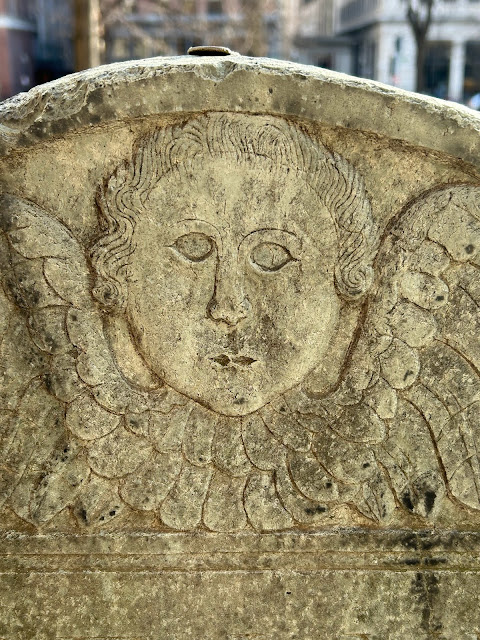I will be the first to admit that moving back to Boston was pretty difficult for me. I didn't want to leave Germany, but I knew we had to come back - not just for the kids schooling, but for our families. I am incredibly grateful though, that we live in one of the COOLEST and most HISTORIC cities in all of America. And I'm lucky because I work just a few minutes walk from many of these historic sites in American history - well, only until this summer, when we move our office to Cambridge.
So I thought that I would take advantage of my proximity to these cool, historic spots on my lunch break. Bonus: I get a nice walk for fitness if I move fast enough, which I do because let's face it... I'm trying to cram this into my lunch break!
The Granary Burial Ground is the THIRD OLDEST cemetery in Boston and it contains the graves of the five victims of the Boston Massacre among other famous patriots from the early days of the US.
In the center of the Burying Ground is a triangular tower tombstone of Josiah Franklin and his wife Abiah, who were the parents of Ben Franklin. Ben himself is buried in Philadelphia.
Despite being in the middle of the city, the burying ground is very peaceful. The mostly slate headstones are not in very good shape, however, as you can see.
Another famous American buried in the Granary Burying Ground is John Hancock.
John Hancock was not only a famous signer of the Declaration of Independence, but he was also the first (and third!) governor of the Commonwealth of Massachusetts.
At some point in the mid to late 1800s, the headstones were moved into neat and precise little rows so that a new invention known as the "lawnmower" could keep the lawn trim at the Burying Ground. That was also about the time they installed the sidewalks. Prior to that, this area was a part of Boston Common and animals used to graze here to keep the grass trim.
Even Peter Faneuil is buried here. The large market building we know as Faneuil Hall was donated to the city of Boston by the wealthy shipping merchant in 1740. Unfortunately he was also known as a slave tradesman - and there's actually a movement currently to have his name removed from the famous hall by Quincy Market.
Robert Treat Paine's marker is along the north/northeast side of the grounds. He was the THIRD signer of the Declaration of Independence. He was also known as the prosecutor against the British soldiers who participated in the Boston Massacre, as well as being the first Attorney General in the Commonwealth of Massachusetts.
Jonathan Jackson wasn't very well known, but he had a really intricate grave marker. He had been a delegate to the Continental Congress, as well as a State Representative, a State Senator and State Treasurer. Interestingly, his great (x5) grandson Patrick is married to Supreme Court Justice Ketanji Brown Jackson!
Founding Father Sam Adams is buried right up front, and it's noted that he was a signer of the Declaration of Independence, Governor of the Commonwealth of Massachusetts (he took over when John Hancock died in office) and a "Leader of Men and an ardent Patriot."
This is the original slate marker of Paul Revere is in the back of the burying ground. Did someone give him a participation trophy for participating in the Boston Tea Party there???
In the 1800s, they places a much larger memorial to Paul Revere right next to the original marker. Paul Revere was, of course, known for his role as the midnight rider who warned the colonial militia in Lexington and Concord that "The British are coming!" Fun fact - he didn't actually say this famous phrase! No one would have said that phrase as it didn't make any sense since EVERYONE still considered themselves British in Colonial America at that time. Instead, he may have said, "The Regulars are coming" which was a term used for British soldiers at the time.
Puritan churches of the time were very plain and did not have a lot of icons or artistic renderings of Bible scenes (and certainly weren't like the flashy and gold Baroque churches that were being built across Europe in the 1600s and 1700s.) Instead, they put their artistry into the tombstones. This popular design was known as the Soul Effigy, portraying a skull with wings. It's meant to signify the soul flying off to heaven.
This appears to be a cherub with wings.
And of course we have the classic skull and crossbones for the Merchant Mr. Benjamin Parker.
There are 2,345 (yes!) headstones here in the Granary Burying Ground, although it's suspected there are more than 5,000 people buried here.
And that, of course, includes the five who died in the Boston Massacre on March 5, 1770 and Christopher Seider, the child who was shot and killed when a British Customs Officer fired his gun into a crowd in an effort to break up a mob several weeks before the actual Boston Massacre. Although the killing of Seider was unintentional, it fueled the Colonists fire.
Samuel Gray, Samuel Maverick, James Caldwell, Crispus Attucks, and Patrick Carr died in the Massacre that occurred out in front of the Old State House at the hands of tense British soldiers. Private Hugh White was guarding the king's money at the Custom House when a bunch of colonists started yelling and insulting him. He struck one of them with his bayonet, and this angered the crowd even more, who started hitting him with snowballs, rocks, and whatever else they could find. He called for backup and a few British soldiers (including Captain Thomas Preston) showed up to help guard the Custom House but the berating and violence continued against the soldiers until one of them fired a shot. And in domino like fashion, several other guns were fired off. Five people died, and six people were injured in the fight.
There was contrary evidence presented at the trial, on whether or not Captain Preston had ordered the shots to be fired but the damage was done. The already strained relations between the Colonists and the British soldiers was severed and would (along with other major events) eventually lead to the American Revolution.
I was leaving the Granary on my way back to work when I noticed this odd sign - No. 19 North Square is in the North End. What a weird place to have a sign about the opening of his house to the public!
Until next time, Granary Burying Ground!





